![[Headline]](../../../technik/sonstige/headtran.gif)
![[Headline]](../../../technik/sonstige/headtran.gif)
The SPIEL Games Convention at Essen / Germany![[SPIEL]](../spiel2.jpg)
No excuses this year ! I got some days free at work especially for this year's convention, and for all of you this means that you once again will get fresh reports during the convention days. As I have done some years before, I will try to bring up as many daily updates as possible, showing you some of the more important games and events... The SPIEL 03Tuesday, 21st of OctoberOkay, the lights are on and the micro is open: "Here is Essen / Germany !" Once again I welcome all of you to 6 days of gaming fever and high activity here at Kulkmann's G@mebox. I left office early today so that arrived at my parent's house in Essen at early afternoon, and for the next 6 days I will try to entertain you once again with some photos and reports from the Convention. Please check back to my page every day - I will try to do an update of my page every day after the convention. 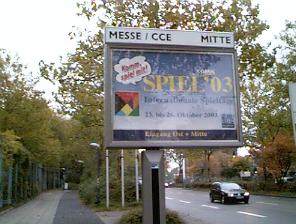 I barely arrived at Essen and climbed out of my car when I already met some old friends who had just arrived at Essen as well: Alan R. Moon and Bob Herried from Funagain Games just were on their way to the convention area, and together we sneaked in to have some first looks around. 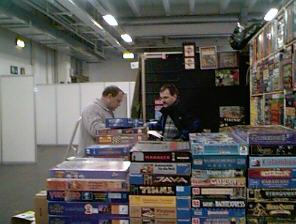 Our first aim was - of course - the used games section, and here Bob directly started on doing business - buying as many games for Funagain Customers as possible. Once again Bob did carry a huge list of wanted games with him, and soon after boxes were filling with hundreds of games to be shipped back to the USA. 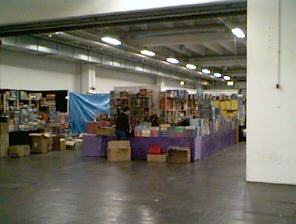 However, most of the used games dealers still were not scheduled to arrive until tomorrow, and thus I left Bob to his business and Alan to some friend and walked around a bit more on the convention area. 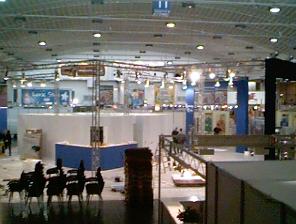 As you can see from the images taken, most of the convention area still was in a state of frantic work, with people hurrying everywhere in order to get stuff to prepare their booths. Some of the booths of major publishers already had taken form, but most of the minor companies still were at the beginning of their preparations. 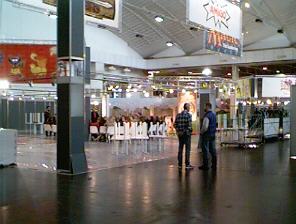 But preparing for the convention means not only to set up a booth, it also means that the publishers have to gather and instruct their staff. Thus, I have witnessed that a crowd of about 50 people had gathered at the AMIGO-booth, and here some instructor went with these people through different organisational questions and also through game rules. During the convention days, these people will teach the visitors how to play the new games presented by AMIGO. 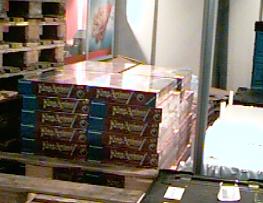 Finally, carefully hidden around a corner, I also found a stack of games which has been awaited to be released for a long time: Ravensburger's "King Arthur" will be released at Essen, and it will also be for sale since several of the game vendors at the convention had received deliveries from Ravensburger with several hundred of these games. Thus, all rumours that the game would not be for sale at Essen were wrong indeed ! Wednesday, 22nd of October - DAY 2Okay, and here we go again ! As I could see in my guestbook, there are at least several of you who enjoy the bit of "convention-feeling" which I am trying to recreate through my reports, and your praise is just the bit of motivation I need... ;-) Anyway, wednesday always is the most busy day for me at the convention, since that day I have to visit the press attendants of most of the more important publishers in order to do a bit of "networking" to keep up my good contacts with these companies. However, the first thing I did this morning after going into the convention was to have another look at the used games section. Still many booths are not built up yet, but I constantly keep an eye on these since I finally have decided to start looking for two games which I wanted to buy for a long time: Full Metal Planete and Supergang. However, I wasn't lucky with any of these games yet. 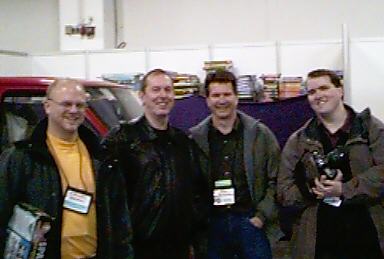 Lurking around the stacks of games I met another bunch of people who had just arrived from the USA. On the image above you see (from left to right) Craig Berg, Alan R. Moon, Greg Schloesser and James Miller. They also seemed rather eager to look for some of the more rare games... 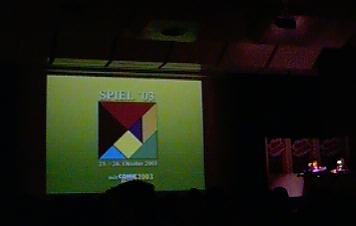 At 11 AM the time had come for the official part of the convention to start. Together with Mik Svellow (from Brett & Board) and I made my way to the Press Conference, and here Mrs. Dominique Metzler from the Friedhelm Merz Verlag gave the assembled press a warm welcome to the convention. During the following speech, Mrs. Metzler relayed a few more facts about this year's convention. Once again, the number of exhibitors has risen by 4 percent in comparison to last year, and that once again means that the convention has set a new record. About 600 exhibitors from 21 nations have set up their booths at Essen this year, and a total space of 38250 square meters is available for showing games this year. As a matter of fact, even that space was not enough. The Merz Verlag was keeping a back list for convention booths, but still they had to refuse the participation of 35 more exhibitors for which no space could be found. Last year, 148000 visitors had come to the convention on 4 days, and Mrs. Metzler was optimistic that this number would be kept this year as well. As for the reason of the continuing growth of the Convention, Mrs. Metzler could define several factor which contribute to this process: one of these is the scheduling of the convention 2 months before Christmas. Many people and gamestores see Essen as just the right place to get first hand information on the new games and thus to find out which games might be asked for as Christmas presents. Another factor contributing to the growth of the convention is that more and more publishers from around the globe see it as a "must" to set up a booth at Essen, since all of the important gaming companies from around the world come to Essen each year. Finally, a factor which is becoming more and more important is that German games are valued for their quality virtually all around the globe. Mrs. Metzler pointed out that these days new customers come especially from Russia, Asia and China. An astonishing example for this has been published by the Korean Embassy: In Seoul more and more "Gaming Cafes" open up. People have to pay entrance to these Cafes and the games presented there usually are german games with german rules. However, more and more young people in Korea have grown fed up with video games and thus these boardgame cafes are in high esteem with the Koreans. At that point I had a little chat with Mik Svellow. We both were of the opinion that german publishers actually could do something to enhance this development even further. Games from Doris & Frank (like Urland) come in bi-lingual versions these days, and nothing would prevent other publishers to follow their example. Manufacturing an english set of rules and putting it into the gamebox wouldn't be too difficult or expensive, and publishers would gain access to a much broader audience if they would consider proceeding this way. Anyway, returning to Mrs. Metzler's speech, she pointed out that about 200 new games would be presented at Essen this year. As for a noticeable trend, the last year showed that more and more popular boardgames even are making their way to the computer, with computerized versions allowing the players to enjoy a game over the internet with sometimes hundreds of miles separating them. Finally, another fact which Mrs. Metzler considered worth mentioning was that for the first time ever now a boardgame even had found its way into the written arts: "Die Siedler von Catan" is a novel which was written by Rebecca Gable, one of Germany's most successful authors of historic novels. 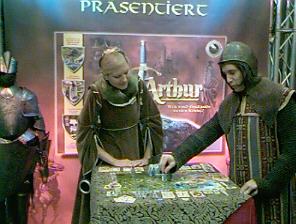 After the press conference I made my way over to the news-show, and here for the first time I saw a copy of Ravensburger's new King Arthur game on presentation. That game got especially much attention by the press, and as I was told by Mrs. Weisshaupt from Ravensburger there never was any Ravensburger game for which some many queries were made as that one. 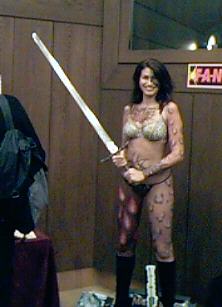 The news-show actually is an event which is held exclusively for the press, and many companies use this possibility to present their new games with some kind of show aspects. As shown above, FANPRO got some "Warriors" there to celebrate the introduction of the new edition of Mageknight, and other companies made similar presentations as well. 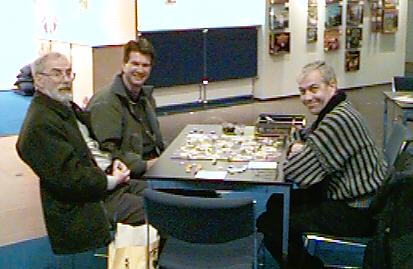 Later that day I again met up with Greg and Mik, who now have been joined by Stuart Dagger (on the left) who had just arrived from England. They were relaxing a bit at the unoccupied KOSMOS booth, and they were giving Die Brücken von Shangrila a first run. I considered joining them, but they qualified the game as being a bit "dull" and since I had to prepare myself for the awards ceremony tonight (and get THIS report done) I rather left them to their happy testing session and went home. 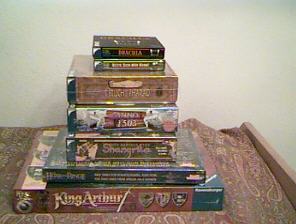 In total, this has been a quite successful first convention day for me. I was able to contact all of the major publishers, and a nice first stack of review copies is sitting on my bed. But don't worry - there is much more games to come. In an hour I will leave for the awards ceremony of the Deutscher Spiele Preis, and that should take up the rest of the day. 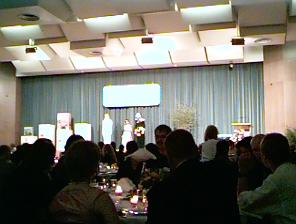 Well, and as indicated earlier, I visited the awards ceremony for the Deutscher Spiele Preis this evening. About 200 guests had been invited to the ceremony this year, and the Merz Verlag had once again arranged for a nice Gala with an exquisite dinner. 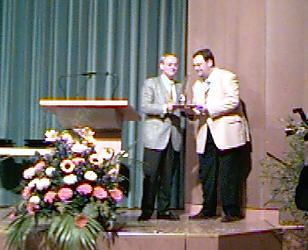 The first award which was given this evening was the Essener Feder, a price sponsored by the city of Essen to award the game with the most outstanding and best understandable set of rules. This year the Essener Feder went to Alhambra, and on the picture above you see the Major of Essen giving the Price to Mr. Bernd Dietrich from Queen Games who had been responsible for the design of the rules. 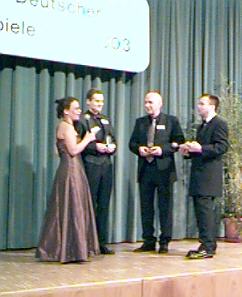 Next came the awards of the Deutscher Spiele Preis, and the top ranking for this year was announced as follows:
On the picture above, you see how Mrs. Metzler presents the awards to Reiner Knizia and Karlheinz Schmiel from HANS IM GLÜCK. 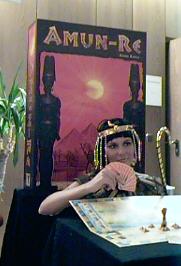 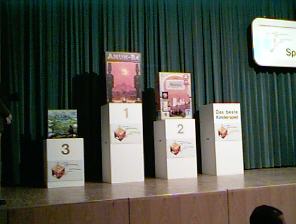 Thursday, 23rd of October - DAY 3And here we are again, on the first "real" day of the convention since it was today that the convention was opened for the public at large. 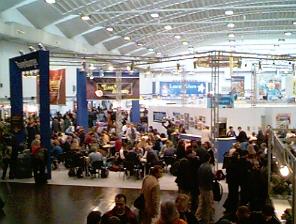 And in they came ! Upon the opening of the doors at 10 AM once again a huge wave of people swapped over into the convention, and within a quarter of an hour all halls were virtually flooded with people. However, this year the crowd was larger than usual for the first convention day, and this was due to the fact that the German state of Northrhine-Westfalia did have school holidays this week. Thus, many more young people were already there for the opening than in the years before. 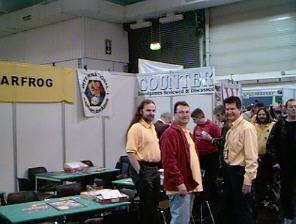 I first made my way to the WARFROG booth, and here quite a lot of folk from the United States and from England were meeting up for the first time. I once again met Greg Schloesser, and since he successfully talked the WARFROG people into letting him hang up a huge "International Gamers Awards" poster he was now busy setting up that poster. Then Stuart Dagger came around too, and he carried a huge poster for the "Counter"-Magazine as well, and that one also was mounted on the booth. In the end, the WARFROG-booth had become somewhat of an embassy for lost and homeless Americans... 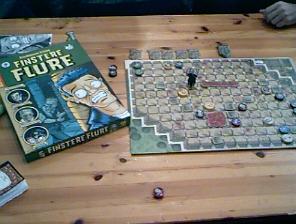 Due to some voice speaking to me from the depths of my Guestbook (Moo!) I thought that spending one or the other visit to some of the smaller publishers would be something you might be interested to read about. Thus, I decided to do my first games session together with Greg, Mik and some of the others, and so it came that we walked over to the booth of Friedemann Friese where we all joined in for a session of his new game Finstere Flure. Finstere Flure actually translates to "Dark Corridors", and I think that the name couldn't be any more perfect for the game we played. Each player took up a party of three people who somehow had gotten into a haunted house, and the players had to try to get two of their figures out of the house by using the exit at the opposite end of the gameboard. As for movement, each figure had an allowance of a total of 7 spaces which it could move each turn, but these moves needed to be split up between the turns as shown by numbers on each figure. However, the most important element of the game is the Zombie which also starts moving on the gameboard as soon as the players have started moving into the house. Each turn, after all players had moved all of their playing pieces, a Zombie-card would be turned around, showing how many spaces the Zombie would be allowed this turn. The Zombie would move straight ahead, but at all crossroads it would also look to its sides as to whether it could see and player figures in the crossing corridors. If it could see a player, then it would turn and start moving towards him. However, the Zombie always needs to move towards the closest player, and since it keeps checking for player figures at all crossroads it could quite be possible that the Zombie would change its direction several times during its move. When a player is captured by the Zombie, that means bad luck for him, since his figure is thrown out of the house and the player has to re-enter the house with the figure. However, there are certain elements and twists in the rules which make the game rather exciting, and there is a much deeper element of strategy in it than might be suspected at first. Thus, if the Zombie faces player figures on both its left and right side, it cannot decide in which way it should move and - dimwitted as it is - it simply continues moving straight ahead. Another feature are blocks of stones which players can push around in order to hide behind them, but no true hiding place can be created this way, since the Zombie can leave the gameboard by walking through the wall on one side of the board and re-entering the board on the opposing side. 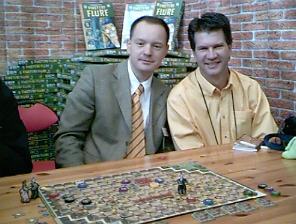 We played the game with a total of six players, and it was won by Greg in the end (by the way, that's me up there on the left hand on the photo, sitting next to Greg. And since this would otherwise cause questions: I am wearing a tie because I had to talk to representatives of several major companies today, and looking a bit business-like is quite advisible with these people). I must say that I rather enjoyed our session of Finstere Flure. The game was really entertaining to be played with that many people, and my overall good impression of it was strengthened even more by the artwork used in the game. All players' pieces were illustrated with artwork from ODC comics, and thus each player did lead a quite unique group into the building (Teeny-Gang, Police-Squad, Priests, the Addams Family etc.) The Zombie itself was made up of several parts, and these could be interchanged to make it looking in different spooky ways. Finally, the game also contained some variant rules and even an english set of rules is available, so that I would say that - despite slight similarities to Roborally - this game certainly is one of the MUST-BUYS at this year's convention. 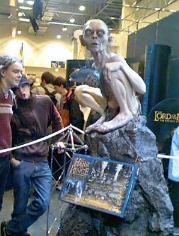 After the game our group did split up and everybody did go his own way to find some more about the convention news. I decided to make my way to Games Workshop, since they had invited me for a presentation at noon. I was there in time, and the new game they introduced to the public was the third part of their Lord of the Rings Tabletop Wargame: The Return of the King. Like the editions of the previous years, the new game contained a new 176-page rulebook (including 14 new scenarios) and a total of 48 detailed plastic miniatures (24 Warriors of Minas Tirith and 24 Mordor-Orcs). Further landscape elements included in this box are ruins and a statue which can be used to decorate the battlefield. Talking to a representative from Games Workshop, I was told that their line of Lord of the Rings games would not come to an end after the release of the third part of the movie. Games Workshop UK actually had succeeded in acquiring the rights to use the full story of the Lord of the Rings for tabletop-gaming purposes, and they are planning to establish their Lord of the Rings products as a third standing production next to Warhammer and Warhammer 40k. Using the chance, I also couldn't resist asking the director of Games Workshop Germany about the chances of a re-relase of some of Games Workshop's classic boardgames (with Talisman being on top of the list), but here the sober news were that no such plans existed for the nearer future. The re-printing of about 10.000 3rd edition games which had been done in the USA at the beginning of the year was a limited deed, but no further such actions were planned as yet. 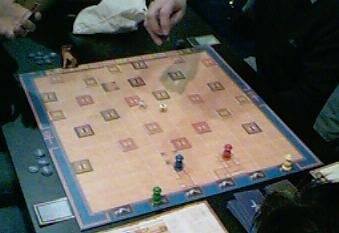 The next stop I made today was at the KOSMOS booths where I engaged in a round of the new game Der Fluch des Pharao which was made by Martin Wallace. In this game each player takes up the role of an Archaeologist, and these Archaeologists have entered a Pyramid in search for hidden tombs and fabulous treasures. However, they did not take the God Ammut into consideration - he walks through the dark corridors and tries to protect the secrets of the Pyramid. The game is rather easy to set up. Several squares at the gameboard show that a random Tomb-marker needs to be placed at them at the beginning of the game, and the only other preparation needed is that the two decks of cards (Treasure cards and Event cards) and also the Maze-Tiles (which are used for movement through the Pyramid) are mixed. Finally, all players place their playing piece in front of one of the entrances to the Pyramid and take 7 Life-markers each and then game can start. During his turn, a player now may decide to randomly draw up to 3 of the Maze-Tiles and he may place these onto the gameboard as to continue any already existing corridors. However, since it would be more and more difficult to add tiles as the game goes on, it is sufficient to place a tile in a way that it adds to one corridor - it thus might create dead ends for any of the adjacent corridors. Once the tiles are placed, the player now takes up the two special dice in order to find out his movement allowance for the turn. He now must move his playing piece along corridors for the indicated number of spaces (i.e. tiles), and whenever a player enters a tomb he may decide to end his turn there in order to look for treasures. A player who first enters a tomb may take the Tomb-marker from that Tomb, and furthermore he will also receive a number of 1 to 3 treasure cards as indicated on the tomb marker. A player needs to collect 12 of these treasure cards to win the game, but some of them might be marked with the symbol of either a trap or a movement of Ammut. A trap means that the player has to discard one of his Life-markers, but the consequences of an Ammun marker are different. At the beginning of the game the Ammut playing piece had rested on a special track outside the gameboard, and whenever the Ammut symbol rises during the game the Ammut figure will be moved forwards on this track. However, when the figure reaches the end of the track Ammut will be called onto the gameboard, and from now on he will move on the gameboard in search of the players. If a player meets Ammut on the gameboard, that will be bad luck for him since he cannot be really victorious over the God. All he can do is to try to fend him off, and to do so the player has to roll one dice and lose as many Life-markers. However, Ammut is not only moved through the means of Treasure-cards. The dice used for movement of a playing piece each also have an Ammut Symbol on one of the their sides, and if a player should roll such a symbol it means that Ammut will be moved. Another point to mention is that certain Maze-tiles are underlaid in a grey colour, and if a playing piece enters such a tile the player is forced to draw a card from the deck of Event-cards in order to find out whether he would be confronted with a good or bad event. The game is won by the first player who leaves the game with either 12 Treasure-cards or a total of 5 differently-coloured Tomb-markers. If however a player should loose all his Life-markers on his way through the Pyramid, then he will be forced to drop all of his Tomb-markers at the place where he died and all his Treasure cards will be discarded. The player will get to start with a new Archaeologist, but if another player should reach the dropped Tomb-markers first than that player may take these up. I must confess that I was a bit disappointed after playtesting this game. The topic of exploring a Pyramid sounded rather interesting, but the game made of it does not do better than average. Even when tested with several players, no real feeling of competition was raised among the players, and somehow the options available to the players do not convey the impression of in-depth gameplay. Considering that Der Fluch des Pharao comes as a "big box game" from KOSMOS, I was also a bit disappointed by the artwork used in the game. As the game was done in co-operation with the British Museum in London, all the Treasure cards show real pieces of art as found in Egypt. However, as for the design of the other playing parts a bit more of an effort on side of the publisher would have been welcome. The game is held mostly in sand-coloured tones, but these only rarely are decorated with other artwork. To my mind, that game definately is one of the weakest KOSMOS-products I have playtested as yet. 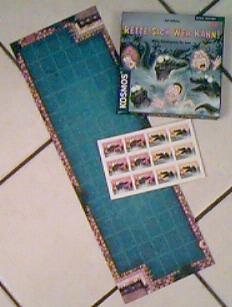 However, I still had not lost my taste for KOSMOS games for today. I had to postpone a testing session of Dracula since there was no free table in sight, but what I did instead was to have a go at another new two-player game: Rette sich wer kann! This game is a rather fast paced game about a hotel swimming-pool which is haunted by Crocodiles, and each player tries to get as many of his own playing pieces through the infested pool to his own pool-bar. The game is set up with each player arranging his own 6 swimmers in 4 rows at the side of the pool which is opposite to his pool bar. Then the game goes in turns, during which a player has to take one of the following options:
A swimmer may be moved for 1 or two spaces in any direction, but he must move through empty spaces and he may also end his movement only on an empty space. A Crocodile however must follow special "Crocodile Movement Rules": Thus, each Crocodile carries a number and it must be moved for exactly this number of spaces. As with swimmers, a Crocodile may only move through empty spaces, but all Crocodiles are a bit more restricted in their movement than swimmers are. Depending on the number of the Crocodile, some Crocodiles may only change their direction once per turn, whereas others may change their heading twice and even others might be allowed to move diagonally. If a Crocodile ends its movement on a space containing a swimmer or a Crocodile of the other player, than that piece will be "eaten" and put beneath the attacking Crocodile. Thus, by eating pieces of the other player, a stack of playing pieces might be built with the uppermost piece showing to which player this stack belongs. All movement rules are applied normally for moving such a stack. At each end of the pool there are three spaces with ladders leading out to the pool bar. The pool bar must be reach with an exact movement number - additional movement points may not be ignored. The first player moving out to his pool bar must have a stack for that movement (i.e. a Crocodile which as eaten at least once). Afterwards, the players also may move out single swimmers and Crocodiles. The game ends when only one player has playing pieces left in the pool. The player who now has most playing pieces (either of his own or the opposing colour) at the pool bar will have won the game. The game went surprisingly fast, and thus I played it several rounds in order to get a bit more familiar with the movement options offered by each playing piece. Although the game is actually quite simple (just one page of rules), the players soon can discover the strategic options which must be considered. A splendid rule is that a player first must leave the pool with a stack of playing pieces before any single piece is allowed to leave the pool. This rule ensures that quite a fuzz is created in the middle of the pool, and each player will try to prevent the other from being the first to reach the end of the pool with a stack. Over all, the game is fast-paced with good competitive values and it also has decent artwork. It thus is a short, funny fill-in which may be played to loosen up... 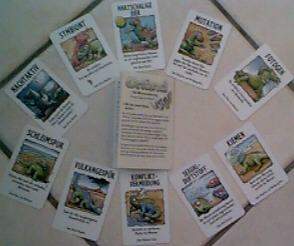 To finish my reviewing of games for today, I also spent a visit to Frank Nestel from DORIS & FRANK. Although DORIS & FRANK did not come to Essen with a new game, they did not come empty-handed either. Some time ago they had started a "gene-contest" for their game Urland, and now on the convention they did sell a small micro-expansion for Urland featuring 10 new cards with genes. Also, the Ursuppe-Expansion and Mü & Mehr had gone into reprint, and these are avaible at Essen as well. However, even with this my convention day was not fully over. I had been invited by the SCHMIDT VERLAG to the annual Spieler-Party at Essen, and I did spend quite a nice hour this evening eating and talking to the people who ha joined me on my table: Dagmar De Cassan and Reiner Knizia. Friday, 24th of October - DAY 4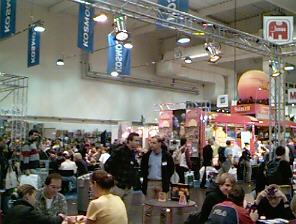 Phew, another day done ! Lots of playing, lots of talking, and a very nice awards ceremony did take up most of the day today, and now all that is left is to get out another bit of news for all of you! 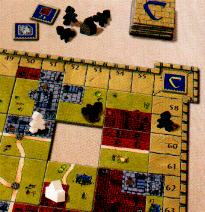 Today I made my first visit to the HANS IM GLÜCK VERLAG, and I was quite surprised to find that a new game had been published in the Carcassonne-Universe, the new two-player game Carcassonne - Die Burg. Even more surprising, this new game was not from the original Carcassonne-inventor Klaus-Jürgen Wrede, but instead by the German Star Author Reiner Knizia. Already while studying the rules I could quickly discover that seasoned Carcassonne-players will find many similiarities between the standard Carcassonne-Rules and the rules of the new two-player game Die Burg. However, the game is set up in a slightly different way, since a playing area will be defined by a multi-part Castle-Wall which is set up at the beginning of the game and which also serves as a track for the victory points. After the Castle-Wall is set up, all landscape-tiles for the game are mixed up and furthermore some additional wall markers will be randomly distributed face down on each of the towers of the Castle Wall. With these prepositions met, the game can start. Like in traditional Carcassonne, a player's turn here consists of three phases: drawing and placing of a landscape-tile, (possibly) placing one of a player's seven henchmen on the freshly placed tile and then (possibly) scoring victory points. As for the placement of the landscape tiles, these show three different kinds of prevailing landscape-elements: Towers, Buildings and Courtyards. Furthermore, minor elements like roads, wells or a market may also be displayed on a landscape tile. Basically, a freshly drawn landscape tile needs to be placed next to an already placed tile or at one of the 7 inner gates of the castle. The newly placed tile must be aligned in a way as to match the landscape features of all neighbouring tiles, so that especially roads will need to be continued. After having placed a new landscape tile, the active player may decide to put one of his henchmen at one of the landscape elements of the newly placed landscape. He may put his henchmen at a Tower (to become a Knight), at a building (to become a Squire), at a road (to become a Herold) or at a courtyard (to become a trader). However the player will need to observe that he may not place a henchman at a particular landscape feature if this feature expands over several landscape tiles and if the other player already has one of his henchmen on that particular feature (the only way to have several henchmen on the same landscape feature is by joining two separate features together by the placement of a matching landscape tile). The henchman will stay where he is placed until the landscape feature is evaluated. If, at the end of a player's turn, a landscape feature should be finished (meaning that it cannot be expanded any more by the placement of new tiles), then the landscape will be evaluated. The player who has most henchmen on that particular landscape will receive victory points, depending on which type of landscape was completed. He will thus receive 1 victory point for each landscape tile a building consists of, 2 victory points for each landscape tile a tower consists of, and 1 victory point for each landscape tile a road consists of (but 2 if the road is adjacent to a well). The players then may take back their henchmen to their stockpile, but since the courtyards will not be evaluated until the end of the game a henchmen placed as a trader will stay on a courtyard for the rest of the game. The player who got the victory points then will be asked to adjust his victory point marker on the castle wall according to the number of points he had gained. However, if the victory point marker gets to land exactly on one of the towers which still contains one of the wall markers, then the player is entitled to take this marker and use it. Some of these markers give the player a small advantage during the course of the game (for example allowing a second turn or to double the points when finishing a certain type of building), whereas other of these markers allow the player to gain some kind of benefit at the end of the game (for example turning an unfinished landscape feature into victory points). Another important element is a player's palace. If a player has finished a building, then he will get to place his special palace marker on that building. However, if he should finish a bigger building later during the game, then he will be allowed to shift his palace marker to the bigger building. The markers are of importance when the game comes to an end. The game will end when the last landscape tile has been placed, and then some additional victory points will be distributed. Thus, the players now can turn in some of the wall markers which they got during the game, and furthermore now also the Courtyards will be evaluated. Like with other typed of landscape features, the player with most henchmen on a courtyard will get the victory points for the courtyard, and he will get 1 victory point for each landscape tile a courtyard consists of. However, he will also get an additional 3 victory points for each market which can be found on that courtyard. Finally, both players will need to compare their palaces, and the player with the bigger palace will get a special kind of reward: he will receive victory points equal to the largest number of adjacent empty spaces which can still be found within the castle. The game then will be won by the player with most victory points. While building on the traditional Carcassone-rules in their essence, it becomes quickly visible that the new game Carcassonne - Die Burg is much more than just another Carcassonne-clone. As a major difference, it is a game for just two players, and what is more important, is that by the introduction of some additional rules a quite well functioning game had been created. Die Burg is a good strategy game which succeeds to captivate players both with its interesting rules and also with its design as a whole, and I can definately recommend the game to a larger audience than just seasoned Carcassonne-players.  Once again the HANS IM GLÜCK VERLAG has decided to offer a small Carcassonne-Expansion for free. These sets are really hard to get due to their limited numbers, but I couldn't resist to show you these new cards... (in a printable format) ;-) The rules for these cards:
Have fun !!! 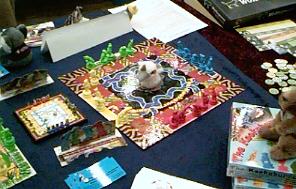 Next I was getting "hungry" to see some game from another small publisher, and here I found someone who had dared to make the long voyage from Australia to Essen this year: EDUALC Z PROMOTIONS with their newly developed Kookaburra Game. This game is about 5 different typical Australian animals, and the players compete to have their group of animals to be the first in a race through the Australian bush. Thus, each player receives a "squad" of 5 different animals: a Koala, a "Schnabeltier", a Kangaroo, a Crocodile and a Kookaburra. However, to move the figures on the gameboard, the players have to observe the unique rules for moving each of the figures. Thus, a Koala only can stop an Eucalyptus-leaves, a Crocodile can eat other animals or a Kangaroo can carry other animals around in its bag. One of the most outstanding features of the game is the design: the gameboard is two sided, and while the first side shows a more or less standard gameboard with paths and rivers, on the other side a more abstract gameboard is shown which was made from original aboriginal artwork. This board and the also quite nice playing figures give the game a quite nice appearance, and the rules themselves offer for a nice and entertaining racing game. In total, the Kookaburra Game is a very good example of how a so far unknown publisher can bring a good and entertaining game to Essen. 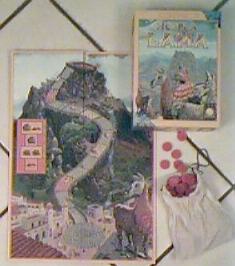 Since the day was getting on, I next longed to play another nice game with good player interaction, and since I did hear some good feedback on the new game from GOLDSIEBER I made my way to their booth. GOLDSIEBER has come to the SPIEL 03 with their new game Hoppla Lama, a game by Roberto Fraga which once again presents itself in one of the smaller GOLDSIEBER-boxes. When talking to a representative from GOLDSIEBER, I was able to find out that a new "big" game was due to be released at the Nürnberg fair in spring 2004, but no hints as to the topic of the game could be gained. Turning now to Hoppla Lama, this game is set against the background of Peruan Indios travelling up a Volcano with their Lamas in order to find out whether there would be any dangers for their village. However, needing some convincing to go up the vulcano, the Lamas need to be lured with some food in order to dare to go closer to the vulcano. At the beginning of the game each player gets two Lamas of one colour. One of these Lamas he places at the village place at the bottom of the vulcano, while the other Lama is not placed on the gameboard as yet. As a final preparation, a certain number of food-counters is placed into a bag from which they can be drawn during the game. Each player's turn is divided into three basic steps: First, the starting player gets to bet on the food consumption for that turn. Next, each player secretly takes a number between 1 and 5 food-counters from the bag and after all players have drawn their food counters their draws will be revealed. And finally, some Lamas will be moved up the vulcano, depending on which player has won the bet on the food consumption for that turn. As indicated, the active bet for the turn is chosen by the starting player, and he gets to chose between 4 different types of bets: He may bet...
Once one or more winners of the betting round have been found, these players will be allowed to move their Lamas up the vulcano. The Lamas must take a number of steps corresponding to the number of food counters which their owner did use in the betting contest. If a Lama ends its movement on a space which is already occupied, the former occupant of that space will be pushed one step backwards towards the village space. If a Lama gets into the crater, then it immediately will run back to the village place where it can cool its feet in the river. Some coloured spaces on the track up the vulcano indicate shortcuts on the way to the crater. If a Lama ends its move on one of these spaces, then it will immediately be moved to the exit of that secret route. After the Lamas were moved according to the result of the betting round, the next player will become starting player and a new round will start. The game will end immediately when a player draws the last food counter from the bag, and at that time all food counters which the players may already had drawn for this' turn's betting round will be returned to the bag as well. Afterwards, the players will count how many food counters they have collected in previous turns, and the player who has collected most counters must move his Lama for an additional 3 spaces up the vulcano, whereas the player with fewest food counters must move his Lama 3 spaces downwards. The game then will be won by the player who has his Lama farthest up the vulcano. With Hoppla Lama GOLDSIEBER had succeeded in creating a highly interactive game where a lot of communication between the players takes place due to the fact that they try to bluff each other concerning the number of food counters which they might hold in their hand. The game is relatively short to play, but it's entertainment value is high enough to guarantee a quite high number of replays. 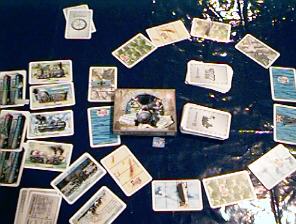 With the International Gamers Awards ceremony coming up at 5 PM, I was left with enough time to make one more visit this day. Another booth which I have to visit every year is the one of KRIMSUS KRIMSKRAMS KISTE where Ralf Sandfuchs and the rest of the KRIMSUS-CREW each year are presenting their new cardgames. This year the have come to Essen to display their new game In 80 Karten um die Welt, a game about a race around the world which is set at the end of the 19th century. In this game each player takes up one of the competing nations, and each nation sends a special steam-powered "Walamob" (Water-Land-Mobile) on the voyage around the world. For playing purposes the "world" is set up in a circle of 12 landscape cards which each have 4 spaces on them. These landscape cards show different types of terrain, and the first player who has succeeded in moving his "Walamob" around all 12 landscape cards will have won the game. The movement procedure is rather easy: a player is assigned action points for the current steam level of his "Walamob", and these action points may be used for moving his playing piece or for visiting a camp were the "Walamobs" can receive some outfitting. Basically, it takes two action points to move a "Walamob" for one space, but as said the players can also visit an outfitter where their vehicle may be fit with special equipment. Thus, a vehicle may receive special movement equipment which makes it easier to move on certain types of terrain, but is may also get crew which might be helpful as well. Furthermore, a player may also obtain some weaponry, and this comes in handsome when one of the other players is getting too much into the lead. A rightly timed Earth-Torpedo or a Rocket might slow the other down - enough to overtake him and to allow the player to take the lead himself. Once again I was surprised on how much gaming components the Krimsus Crew were able to squeeze into the small box of a cardgame. Using 110 cards, In 80 Karten um die Welt presents a perfect little boardgame with gameboard, playing pieces, markers and - of course - a large set of playing cards. The game is quite funny to play and it recreates a good racing-atmosphere between the players. It reminded me a bit of one of those old movies about airplane or car races, and it is definatly as funny as these old films. International Gamers AwardsAnd then the big moment came - many committee members from the IGA-committee met with quite a few authors and publisher representatives at the (almost traditional) ALEA-booth where Greg Schloesser presented the winners of the International Gamers Awards. 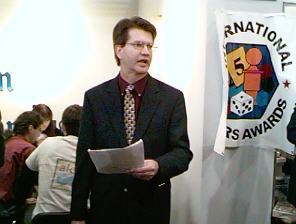 Greg once again had prepared a speech in German, and he did his very best to pronounce all these difficult german terms to the large audience. He did splendid and introduced the public with some words to the meaning of the IGA and how it is awarded. 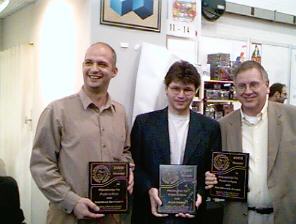 Next came the awards themselves, and first he now gave a plaque for the Spring 2002 Boardgame Awards to Andreas Seyfarth for his game Puerto Rico. In turn, a plaque was also given to ALEA and RIO GRANDE games for being the publishers of this fine game. 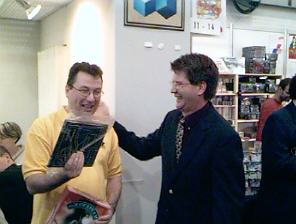 The 2002 / 2003 Boardgame Awards then was given to Martin Wallace and WINSOME GAMES for publishing Age of Steam. 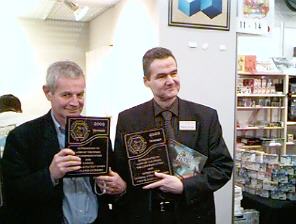 Finally the 2002 / 2003 2-Player-Game Awards went to Reiner Knizia for his great Lord of the Rings-adaption The Confrontation. And, of course, the publishers of these games - KOSMOS and FANTASY FLIGHT GAMES - received a plaque as well! 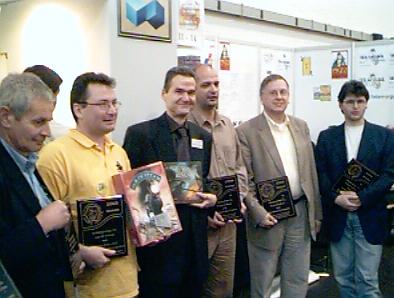 Overall, Greg did a great job with the presentation and it couldn't have gone better since all authors and company representants had attended. What a day... I wish it had 36 hours... Saturday, 25th of October - DAY 5One of the great advantages of the SPIEL is that you cannot only see the new games of today, but sometimes you can also have a good look at some games which may become the awards winners of tomorrow. 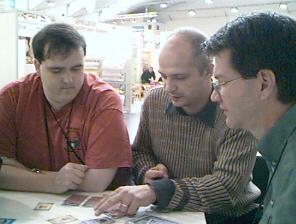 Yesterday, when we held the International Gamers Awards ceremony at the booth of ALEA, we also could see that Andreas Seyfarth had bought with him a few prototypes of the his new cardgame San Juan which is based on his successful game Puerto Rico. Greg and I both asked Andreas whether he would actually be willing to teach the new game to us, and thus we did agree to meet this morning at 9.30 AM at the ALEA booth. This was half an hour before the Convention opens, but such an early date was advisible since the tables at the ALEA booth usually are occupied all of the day. Thus, we met together with Craig Berg and Chris Miller this morning at the suggested place, and Andreas started teaching us how to play San Juan. 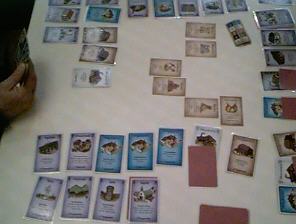 As a matter of fact, San Juan certainly carries some big similiarities to the bigger Puerto Rico, but on the other hand the playing mechanism has been changed considerably so that the new cardgame is not just a "cloned version" of the bigger boardgame. Quite interesting, the whole playing mechanism is driven through the same set of playing cards, since these cards are the buildings which the players can build during the course of the game, but - if turned on their backside - these cards also serve as resources and as money. At the beginning of the game, each player gets a random hand of 4 cards, and with these few cards he will need to think about a strategy on how to begin the game. Following the same basic order of players as in Puerto Rico, the players now each in turn chose one of 5 different occupations which will pre-define their actions for this turn. Thus, the Prospector allows the player to draw an additional card, the Builder allows the erection of new buildings, the Overseer is needed to produce new resources on any production buildings and finally the Trader can be used to sell resources. An additional occupation is to become a member of the City Council, allowing the player to draw several new cards and to keep one of these. Once a player has acted on the occupation he has chosen, the other players get a chance to perform that action as well, with the exception that they won't get a certain benefit which the starting player for that round did get. When all players had chosen an occupation, then the round will be over and the next player will become Gouvernor and starting player. Most essential for the players is to have some fitting buildings in their towns. All buildings have special abilities which brings some benefits to the player (allowing production, enlarging the size of a player's hand etc), and a player needs to decide rather well on which buildings he should add. The game will end as soon as a player has built his 12th building, and then the victory points as written on each building can be turned in. The player with most victory points will have won the game. As I said earlier, I consider San Juan to be a quite good stand-alone game, and due to its intriguing playing mechanism I am sure that this cardgame will find as much appreciation as the boardgame did. 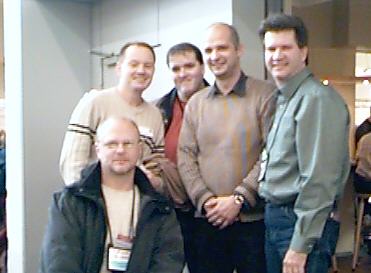 By the way: our game was won by Greg with a bare 1-point lead over James Miller. I had a good start but I had incredibly bad luck at the end of the game when I couldn't find any of the more expensive buildings to increase my victory points. However, as Andreas told me, a bit of a luck factor was quite intended in this game to keep it a bit lighter than Puerto Rico was. On the picture above you see from right to left: Greg Schloesser, Andreas Seyfarth, James Miller, me, and sitting Craig Berg. 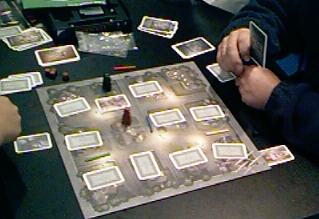 A game I told you I was rather eager to playtest was Dracula from KOSMOS' rather successful series of two player games. Knowing the old GAMES WORKSHOP classic Fury of Dracula, my curiosity was roused whether the new game could stand a comparison as far as gameplay and playing depth are concerned. The first striking factor about Dracula is its appearance. The Box is held in black with bloody Vampire-fangs on the front cover, but upon opening the game I was quite taken by the high quality of the included playing materials. You get a nice map for some dark part of London, two decks of cards with excellent graphics, two wooden playing figures and Energy stones and 4 coloured barriers which can be placed on the gameboard. Now to the rules: In this game one player takes up the role of Count Dracula, whereas the other player assumes the rule of his sworn enemy Professor Van Helsing. Dracula has come to London in order to spread Vampirism in England once again, and Professor Van Helsing must try to locate all of Dracula's Vampire-Tombs before Dracula can find all of his victims. At the beginning of the game, each player receives a deck of 10 action-cards and 15 location-cards. The action cards are mixed up and each player receives 5 random action cards from his deck as his hand while the other 5 cards are placed aside - the players will get these when they have used up their first hand of 5 action-cards. Each player also secretly choses 6 of his location cards, and these cards will be mixed together and randomly placed face-down onto the 12 different locations on the gameboard. Finally, each player receives his 4 Energy tokens and may place his playing figure on the starting position on the gameboard (opposite corners). A player's turn consists of two actions - moving his playing piece and afterwards playing an action card. The players may move their playing piece between adjacent locations, and whenever they have reached a location they may decide whether to look at the location-card which has been placed there. If a player decides to look at the card and finds a card from his own hand of location-cards he may put the card into his hand of location-cards and exchange it for any other card from his hand (or do a bluff and put down the same card again. However, if a player finds the card of the opposing player, then he has no choice but to end his movement, reveal the card and to act on the shown event. Basically, a location card can show one of three different events. The most common event is that the player has discovered a Henchman of the other player (i.e. a Vampire or a Vampire Hunter). This Henchman must be fought by the player. The next possibility is that a Symbol of Power of the other player is revealed, and this means that the player has to loose one of his Energy-tokens. The final option is that Dracula discovers one of the 5 victims or that Van Helsing finds one of Dracula's 5 Vampire Tombs. Finding these cards is the aim of each player, and the first player who has found the complete set of 5 cards will have won the game. After the player's movement has ended (and after possibly revealing the location card on which he stands) the player now must play an action-card from his hand. The action cards had 4 different attributes which are printed on each card, and each of the attributes will come to bear when a card is played. Thus, the first attribute of a card is that it shows a player's maximum movement allowance. Here it must be remembered that the action-card is played after a player's movement, so that a player's choice of action cards is narrowed down the farther he wanders. The next attribute on the card will be the fighting strength of the player. If he had discovered an enemy Henchmen at the end of his movement, the player now will compare the Henchman's strength with his own strength as printed on the action-card. If the player is stronger, he can discard the henchmen and gets to put down one of his own location cards at that location. If the player is weaker, he will lose one of his Energy tokens (if a player looses all of his Energy tokens the game is over for him). If the player and the Henchman tie nothing will happen. Next, as a third attribute each card also contains a special action, and these action will influence the rules in some way to give the player some minor advantage. And as a final attribute, there is a symbol on the action-card showing one of the four coloured barriers. The depicted barrier may be placed or moved on the gameboard, restricting travel between two neighbouring locations. Once again I must confess that I am quite taken by the quality KOSMOS puts into its series of two player games. To my mind Michael Rieneck's Dracula offers a perfect set of rather well playable rules, and my overall good impression of the game is strengthened even further by its appearance. The game does not need to shy away from a comparison with Fury of Dracula. This older classic offers for a longer and somewhat deeper gameplay, but the new Dracula simply is perfect entertainment at a slightly lower level of complexity. A definate MUST-BUY! 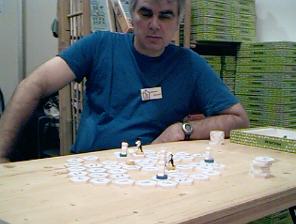 Turning once more to smaller publishers, another publisher which I just needed to visit was the BAMBUS SPIELEVERLAG. I wanted to see their new game Pingvinas (= Penguins), and I was lucky enough to find the author Günther Cornett with some free time to introduce me into the game himself. Pingvinas is a gem for 2 to 4 players, and on a drifting shoal of Ice each player tries to get as many fishes with his four penguins as possibile. The gameboard is made up from white hexagon-tiles which are randomly put together, and each tile has either one, two or three fishes printed on it. After assembling the gameboard, the players in turn may place one of their penguins on one of the tiles, and then the game already may start. What a player does do during his turn is that he moves one of his penguins. He may move it in a straight line in one of the six possible directions, but he may not move over or through other penguins or over gaps in the ice. Such gaps will be created by the players, because - after moving their penguin - they will be allowed to take the tile which was occupied by their penguin out of the playing area and put it into their own stockpile of fishes. As the number of gaps on the gameboard increases, it becomes more and more possible that penguins get cut of from other parts of the shoal, and within a matter of several rounds the shoal will break up in ever smaller pieces. In the end, the player who has captured most fish with his gang of penguins will have won the game. To my mind, the new game from Günther Cornett once again illustrates how successful a small publisher can be in creating quite interesting games with just a little ingenuity. Although the rules may sound quite simple, the game offers room for quite a bit of playing strategy. 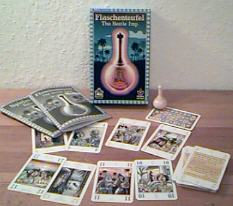 Günther Cornett also presented me his new cardgame Flaschenteufel ("The Bottle Imp"), a title in his new series Literatur und Spiel. The game is named after the novel by Robert L. Stevenson, which is a novel about a bottle imp who can fulfil all wishes. If however the owner of this bottle would die while still being in possession of the bottle, his soul would be doomed in lost to the devil, so the bottle needs to be sold on. But there is a hook: the bottle only can be sold at a price below the price at which it was bought... The game itself is a typical cardgame with cards numbered between 1 and 37. These cards will be evenly distributed between the players, with the exception of No. 19 which will be put openly on the table with a bottle-marker on top of it. This card will be the initial value of the bottle. In turn, the players now will play one card per round, and the player who has played the highest card into the round will get all cards of the round. If, however, a player has played a card with a value which is lower than the current value of the bottle, then that player will win the round and get all cards - together with the bottle. Consequently, the card that player played also will become the new current value of the bottle. The game continues until all cards have been played. Afterwards, each player will get victory points according to the values of his cards, with the exception of the player who became the last owner of the bottle. This player will loose points according to the value of his cards. Playing several rounds, the game continues until the first player has reached a fixed sum of victory points. Flaschenteufel actually could convince me of its very high quality because of a number of aspects: first, it combines literature and gaming, since it is based on a topic taken from literature (a copy of the short story by Stevenson is included!). Second, the game comes with very fitting and quite beautiful artwork and also very good rules. And third, game-rules, playing cards and the novel are included both in English and in German. I do not know what else a player could expect of a game, but I would say that this new concept for games certainly has a bright future! (Note: The game is for 3 or 4players, but a two player variant is included.) 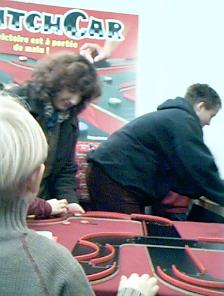 I can also bring some news about a Jean Du Poel game, and this certainly should make quite a lot of people happy: Jean had succeeded in finding a new publisher for his former Goldsieber game Carrabande, and under the new title Pitchcar the game now is available from the publisher FERTI. Even an expansion set is available, but when considering the relatively high price of 55 Euro I wonder whether it would not have been possible to add the small expansion into the basic game. 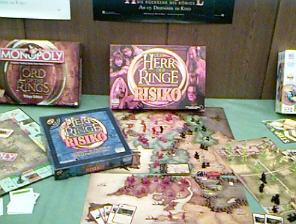 To finish this day, I finally visited HASBRO who actually has come to the SPIEL 03 with 2 new games from their Lord of the Rings range of products. One is a Lord of the Rings Monopoly which takes up elements from all three parts of the movie, whereas the much more interesting new game should be the new Lord of the Rings RISK Expansion. There have been some rumours that this expansion would not be released, but as I was told by Mr. Mutz from HASBRO these rumours had not been true at any time during the previous 12 months. As a matter of fact, he could not explain where these rumours did come from. The new Lord of the Rings RISK expansion actually is two games in one. On the one side of the gameboard the players will find the missing part of the map from the main game (adding Mordor and Gondor), and together with 2 new armies the Risk-game now can be played with up to 6 players on a much bigger map. Even more interesting is the new Risk-variant game which is included on the backside of the gameboard. Richard Borg had created a nice game around the Siege of Minas Tirith, and here the Orc and Human game pieces are used for a 2-player game which emulates this battle. However, the standard Risk rules had been changed in quite a few ways for this game, with one example being that the different kinds of units now come to have different abilities in combat. Talking to Richard Borg, he outlined to me a bit of the difficulties he had to face while designing the game. When HASBRO had offered him the opportunity to design the game he simply had to do it - being as much a Lord of the Rings fan than most of the world. However, he had to face the limitation that HASBRO had given him the freedom to design the rear of the gameboard and a total of 18 cards. The rest of the game had to be made up from the playing components of the RISK-game, and thus he had to produce a game with pre-defined materials. A hard task! This new expansion is an absolute MUST for all players who liked the Lord of the Rings RISK basic game which was published a year ago. The expansion now allows to play a much better and complete game, and the additional two-player variant is quite a nice extra in this box! Sunday, 26th of October - DAY 6 - FINAL DAYWell, and here we go once more ! Final day today, so be prepared for a big surprise packet of some highly popular games and also some more unknown titles which I thought that they needed some attention as well... 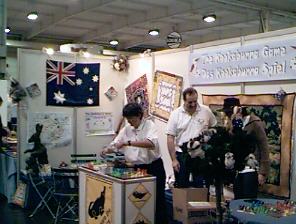 The first thing to do for me this morning was to make a re-visit to the booth were the Australian Kookaburra Game is displayed. I got an email from a reader who wanted to know whether there existed some alternative rules for the game, and I was told that a former edition of the game contained somewhat incomplete rules. This is going to be rectified quite soon: in a couple of days the most actual rules will be available for downloading at the Kookaburra Game Website. Luckily this morning my camera still was all empty, so I could take a picture for you of the quite beautiful booth at which EDUALC Z PROMOTIONS presented their game (it looks like the Australian Embassy). Talking a bit further to the game designer, he was rather satisfied with the Essen convention. He actually agreed with the german publisher HEIDELBERGER that they would manufacture the game in German, and thus this is once again an example of how a well promoted game from a rather small company can find its way onto the german market. 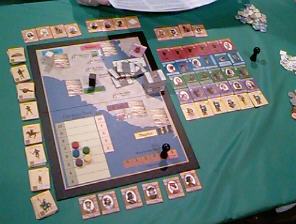 Going international this morning, I changed over to the WARFROG booth to get a bit into their new game Princes of the Renaissance. In this game the players take up the roles of Mercenaries in medieval Italy, and they try to gain influence in the different city states by waging wars for them and engaging into politics. The game essentially is an auction game, and during the course of the game the players will get the opportunity to auction different characters from the five cities which can be found on the gameboard. Apart from the special abilities these characters might have for the players (bringing additional army units, allowing to veto a war etc.), these associating with these characters for the players also means that they will get more interested in the fate of that city during the game. This is because each of these cities wins and loses status during the course of the game, and in the end the players with the highest engagement in cities with highest status will have won the game. The game offers room for a lot of interaction between the players. Thus, the players usually will build up armies and wage wars for the different cities, they may use special spy cards on each other, and further interaction is strengthened through the auctions and other political actions. The game actually carries some in-depth rules, and is can certainly be held true that many elements of Macchiavelli's rules for good governance can be found in one way or the other in the game. There is a lot of trading, negotiating and intrigue going on between the players, and the quality of the game although is reflected by the fact that - although a runaway leader is possible - it is always possible for the players to team up and keep the game balanced. The game is suitable for 3 to 6 players, although with just 3 players the political aspects of the game get a bit into the background. 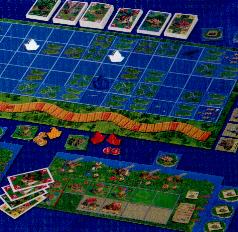 Now for a game which had been rather expected by the gamer's world: although quite a few KOSMOS-games had been adapted to the computer in the previous years, quite less computer games had been adapted as boardgames. With the new Klaus Teuber game Anno 1503 KOSMOS had set to the task of adapting the rather successful computer game Anno 1503 by Max Design, and I was quite eager to see how this rather new kind of a symbiosis between a computer game and a boardgame might work. The new boardgame offers a lot of similarities to the computer game (not last because of the 1:1 graphical design of the game which uses graphics from the computer game), but also because of the choices available to the players during the course of the game. A player must have fulfilled three out of five victory conditions to win the game, and these conditions are:
At the beginning of the game each player will receive his own playing board for his home island. This island actually will be the focus of most of a player's actions, since this will be the place where a player may place new Pioneers and develop them and where a player places Public Buildings and furthermore also the production values of each player are printed on his island. For preparation, each player will receive one Pioneer and one Settler (a Pioneer which ad been developed) and he will places these at the starting positions on his building track. Furthermore, each player will receive one resource of stone and wood (The following resources exist in the game: stone, wood, tools, linen, spice and tobacco. There also exists a main board for the game, and here a number of island markers are randomly distributed face down in order to be discovered by the players during the course of the game. Each player gets to place one of his ships on the mainboard at the beginning, and during his turn he will be allowed to move around with this ship and discover the different islands on the board. The game then may start, and in turn the players now will try to improve their colony by their actions so that it will fulfil 3 of the 5 victory conditions. The first thing a player does in his turn is that he rolls a dice to find out the production for himself and all the other players for that turn. Each player compares the result of the dice-roll with the production values printed on his island and takes a corresponding resource card. At the beginning, the choice of this resources is limited, since some of the resources only will become available through harvest if a Trading Post can be founded on one of the islands on the mainboard. The next phase will be the player's building and development phase, and by paying certain resources a player now can build new ships for the mainboard and he can also develop his Pioneers into Settlers, and these may be further developed into Citizens and Merchants. Apart from building and development, a player may also use his resources for turning them into gold by selling them to the inhabitants of his isle. He may sell one resource per turn to each of his inhabitants, and these will buy resources depending on their current status of development (the Merchant, for example, will buy tobacco). The gold in turn may be used by a player to purchase any needed resources at a cost of 6 from the bank, giving him access to everything but at quite high prices. After this trading phase, the player next gets to spend action points on his ship(s). He may move the ships around on the mainboard, and when a ship comes to stand next to an undiscovered island then the player may spend a further action point and have a secret look on the other side of the island marker. These markers may be of one of three different kinds: They can be Tradeposts, Trade Contracts or a Treasure. A player may decide whether he wants to take the island marker, and if he does so he may place it next to his home isle. A total of 4 Tradeposts and of 3 Trade Contracts may be placed next to the Isle, and they offer the following benefits: A Tradepost means that a player now has the possibility to gain resources which he could not get at the beginning of the game (spice or tobacco), and for each Trade Contract a player must pay one gold less to buy a resource from the bank. Finally, a Treasure is not placed next to the island, but it is turned into an advantage immediately: the player will gain either 12 gold or he may develop one of his inhabitants to the next stage for free. Two more factors need to be told about the game: on the one hand a result of a 6 while rolling for production means that nothing is produced this turn but instead a random event is caused. This may be either Pirates or a Fire (resulting in the loss of a Tradepost or an Inhabitant if the player cannot prevent the event by paying gold), or the result will be a "Golden Year", giving each player the option to take a resource of his choice. The other rule concerns public buildings: Whenever a player adds a new Pioneer to his island he may also place a new public building next to the pioneer. Apart from counting for one of the victory conditions, these public buildings also give small advantages to their owners (preventing losses through Pirates or Fire, allowing higher sales etc). When having a first look at the playing components I was rather irritated by the slightly unfamiliar look. It definately takes a bit to get used to see computer graphics being used in a boardgame, a fact which results in playing components with quite strong colours and a quite different drawing style than in other boardgames. However, more interesting is the question how good the new boardgame actually has adapted the playing mechanisms from the computer game, and here it must be said that Klaus Teuber actually succeeded in creating a game which comes close to the computer game but which - naturally - could not introduce all of the aspects available on the computer. Mr. Teuber designed a solid "Build & Development" game from the given components, and the game certainly can appeal to fans of the computer game and normal gamers alike. However, to my taste the rules do not offer enough variation and new elements to rise the game into highest rankings - it is a bit too much in the mainstream direction for games... 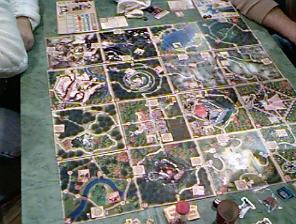 A game which I had not heard of yet but which captured my eye while passing through the convention was Die Rückkehr der Helden (="The Return of the Heroes"), a new game released by PEGASUS SPIELE. The game actually bears quite a few similarites to the GAMES WORKSHOP classic Talisman because the players travel over a fantasy world and meet all different kinds of events and monsters. However, the game offers more variety concerning the gameplay: quests, a flexible gameboard and especially the possibility for the Heroes to train and enhance their characteristics are just a few of these extras, and talking to the author I found out that the game had been much more influenced by the AVALON HILL classics The Mystic Wood and Magic Realm. The game is sold in three different editions, with the luxury edition containing 10 Ral Partha Miniatures as playing pieces and the special edition containing neatly painted miniatures. A very nice treat is that the miniatures had been chosen before the character cards were designed, so that the look of the characters on the cards actually matches the miniatures rather well. Also quite nice is the idea that the character cards can be turned to show the same Hero either as a male or female - just as the player likes. The only problem is that the game so far only is available in German, but depending on its acceptance an english language version is not fully out of the question. 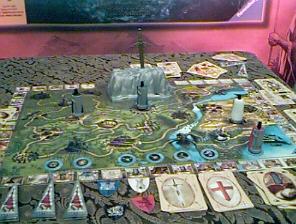 Staying in the area of fantasy games and having found a free table at the RAVENSBURGER booth, I finally also got around to playtest the new and long awaited King Arthur electronic boardgame by Reiner Knizia. Because of the strong presence of this game in various media and a quite resourceful commercial campaign by RAVENSBURGER I had become really interested in playing this game, and thus I was quite happy to finally get a chance to do so. Apart from this initial curiosity, I also wanted to find out whether the game actually would hold the promise of the publisher that it would be the first boardgame with electronic intelligence. I still remember the old MB game Atlantis (Dark Tower) which was released about 20 years ago and which also made use of electronic parts, and thus I wanted to see whether King Arthur really would be much better. The aim of the game is clearly set right at the beginning: to become worthy to pull the sword Excalibur from the Stone and thus become King of England. To become worthy, a player needs to collect a total of 40 points of fame and a Knight's equipment: A Lance, a Horse and a Shield. Basic components of the game are the gameboard with the electronic device and the 4 Knight figures which are the playing pieces, a deck of 45 resource cards (15 each of Sword, Shield and Rations), and about 20 special adventure cards which show characters which might join the players or special items which might be found. At the beginning, each player starts with 10 points of fame and furthermore one Sword, one Shield and one Rations card. Setting out from the place of the Sacred Stone, the players in turn may move from place to place on the gameboard, and whenever they have come to a new place they may position their playing piece over the electric circuits in the gameboard so that they may "explore" the new site by putting one of their fingers on an interaction button. In many cases, the player now will meet one of the different characters who can be met in the game, and he will hear the character's voice speaking from the electronic device while at the same time a number is displayed by the device. This number can be cross-referenced with the frame around the gameboard which shows images of all the characters which can be met by the players, thus giving the players some knowledge on how the character looks like. In the following interaction phase many things might happen: an attack by a Knight, a meeting with a Prophetess or a Druid, an ambush by a Dragon etc. During these phases the player at some instances will be asked how he will react to the situation, and by pushing the corresponding button he may chose to react friendly, to attack, to flee, to ignore the stranger or to agree to a trade which is offered. Depending on how the player has reacted, he now will either loose or gain resource cards or points of fame. If a player has collected enough resource cards, he may visit a Castle and buy one of the three pieces of Knightly Equipment which he needs to win the game, and furthermore resource cards may also be exchanged for "Pendragon Banners" which - in turn - can be changed into points of fame as well. Sometimes an interaction on the gameboard will cause a special result, and this will mean that the player will be asked to add one of the special adventure cards to his hand. Thus, a player may be joined by Sir Lancelot or a beautiful Princess, or he may find a Golden Sword or a Dragon's Treasure Trove. These cards then can be used like normal resource cards, with the exception that the usually are worth more than just one resource. Thus, these cards are useful for hoarding a few resources, since a player only is allowed to hold a maximum of 8 cards on his hand. As for interaction between the players, it might also happen that a player may find a special Potion. If he then gets onto the same space as another character, he may drink the potion and this usually will allow him to take some resource cards from the other player. As indicated above, the players need 40 points of fame and all 3 pieces of a Knight's Equipment. The first player who has fulfilled these conditions and returns to the Stone will have won the game. As a matter of fact, I am really hard pushed to evaluate this game fairly. Because of all the announcements which had been made about the game in the last months I had quite high hopes as to the quality of the new game, especially considering that Reiner Knizia actually did the design of the playing mechanism. When playing the game however I soon had to discover that the game certainly has its limits. While the basic playing mechanism as outlined above works fine and smoothly, the game somehow lacks real depth concerning the gameplay. Encounters with characters usually are held rather short, and apart from a few interactive elements (which are quite easy to guess at) the game does not offer too many choices for the players and even less interaction between the players. The game is rather straightforward and for the players it is simply a mater of time (not really strategy) until they will have collected all the items needed to become King. Furthermore, the handling of the game itself may be a bit tricky. The games works perfect in about 90 percent of all cases, but a friend of mine who has rather dry skin on his hands couldn't use the interaction elements of the gameboard although he did try many times. In the end, it was me who did make all moves for him since my hands seemed to be perfect to operate the gaming functions. Apart from this, one major disturbance was caused by the programming of the electronic device itself: Merlin, the loyal advisor of the players, always will direct the players to certain places where they can collect free resource cards or free points of fame, and because the gameboard is comparatively short players usually could travel to these places within a maximum of two turns. When the places were reached, Merlin already gave another hint for just another of these rewards, and this resulted in the players often running around and simply collecting Merlin's rewards. This turn of events certainly was quite dissatisfactory. To sum it up, I would say that King Arthur is a game which is best suitable for children at ages between 8 and 15 years. The children will have great fun with the interactive elements and the voices and sounds comming from the electronic device, and for them the game will have a very high entertainment factor, thus making it a perfect family game. The game certainly can make a stand for itself if compared with MB's old Atlantis, but if you keep in mind that Atlantis is 20 years older (!!!) you cannot refuse the conclusion that the new game does not mean a great jump forwards for the gaming industry. As a matter of fact, I was rather irritated by the fact that the over 30 different characters which can be met in the game all are represented by about 4 different speakers. Since the electronic device has enough storage capacity for the voice recordings, I cannot understand why RAVENSBURGER did not use a few more different voices in the game. Also, despite the fact that Reiner Knizia himself has worked out the playing mechanisms, the game still remains somewhat superficial and will not have too much appeal to any grown-up gamers. Kulkmann's home brewed King Arthur Rules:
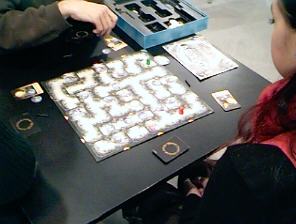 Just like GAMES WORKSHOP and HASBRO, RAVENSBURGER also will publish another Lord of the Rings game to celebrate the arrival of the third part of the movie. However, unlike the years before, RAVENSBURGER has decided against doing another cardgame and instead took out and re-designed one of their rather successful titles: Das verrückte Labyrinth by Max J. Kobbert will be published in a special Lord of the Rings Labyrinth edition, and the game is to be released shortly after the convention. 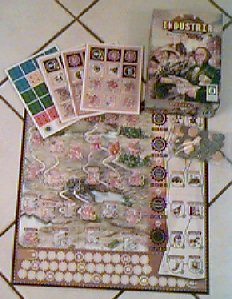 Since the experience of playing King Arthur had left me somewhat unsatisfied, I needed to find another game to cheer up. I had heard a for good things about the new Industria by QUEEN GAMES, and I thought that this might just be the game I might want to play now. After the great success of Alhambra - Mr. Dietrich from Queen Games told me that it was sold over 400.000 times - I was rather eager to see how the new QUEEN GAMES product Industria by Michael Schacht would meet the new standard as it had been set by Alhambra. In this game, the players take up the roles of "Industry Tycoons" who have to manage and expand their family's enterprise through a period of 600 years. With the game being divided into 5 epochs, the players will try to acquire resources in order to build industrial plants and technology which was available in each epoch. In essence, each epoch is divided into a total of 3 or 4 turns (depending on the number of players), and each of these turns is divided into 5 phases during each of which all players get a chance to act. All preparation that is needed for the game is that the 12 industry cards for each epoch (containing industrial plants, new technologies, resources and bonus cards) are randomly shuffled and placed next to the gameboard in hidden stacks. Then all players need to take the markers corresponding to their playing colour and then the game can start. The first phase of a turn is that each player gets an income of 1 Taler (currency unit), and afterwards a number of industry cards from that epoch corresponding to the number of participating players will be turned over. Then, beginning with the starting player for that turn, each player will assume the role of an auctioner, chosing one of the revealed industry cards and auctioning it between the players. Each player now may either bid for obtaining that card or pass, and when play has returned to the auctioner it is he who may decide whether he actually takes the money from the highest bidder and auctions another industry card or whether he takes the industry card for himself without paying for it and then allows the next player to take up the role of the auctioner for the remaining cards. Once all cards have been auctioned off, the next phase will follow with the building of new industrial plants and the discovery of new technologies. Here the players now may use the industry or technology which they had won in an auction and they may bring it onto the gameboard, provided that the have enough money (and possibly resources) to pay the building costs of this industry or technology. Income is generated each round (and from auctions), but to gain the possibly needed resources to build such an industry card a player has to resort to other sources. Thus, a player may be lucky that the resource needed is produced by an industry which he already owns, but otherwise he will be required to purchase a resource from one of the other players or possibly from the bank. However, the bank only offers resources which could be obtained in previous epochs, so the resources on offer there sometimes are not useful in the current epoch. The players collect victory points by placing new industries and technologies on the gameboard. However, there are certain limitations as to whether a player really will be allowed to collect victory points for building or discovering something. Thus, an industry will only bring victory points when it is built in the same epoch when it was auctioned, and even more strict is the treatment of technologies, since these only can be built in the epoch in which they were auctioned. When all players had collected their victory points the next player will become starting player, and when all industry cards were auctioned off the next epoch will start. After the last epoch the game will end and some final victory points will be distributed. Now the bonus markers which could also be won in auctions can be turned into victory points, and players also will get victory points for associated industries or technologies. Finally, the game will be won by the player with most victory points. Well, I must confess that I was quite surprised to find that - after the success of Alhambra - QUEEN GAMES actually succeeded in publishing another game which can meet highest standards. I think that Industria is a very nice strategy game with a quite resourceful set of rules and an interesting scoring mechanism. What is more, the game actually captures its background story of 600 years of industrialization rather well and succeeds in captivating the players from the beginning. For me, it would seem that that this new QUEEN GAMES title once again is bound to rise quite high in the charts... 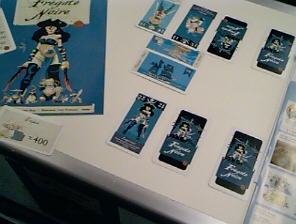 Having playtested enough of the well-known titles in my four days of the convention and being in a mood to test some more games from smaller publishers, I made my way to the small french publisher TOODOO where the author Christophe Berg presented two of his new cardgames. The first game I took a look at was Fregate Noire, a game about piracy and ship-to-ship battles. In the golden age of piracy the players set out with their ships to plunder rich merchantmen on their way through the Caribbean, and when it comes to boarding actions it will be the crews of each ship which are pointed against each other. Most striking about this game is the comic-art illustration of the playing cards, but when playing the game I had to discover that - despite the fact that it is a game designed for 3 or more players - a game usually runs rather fast and the players tend to drop out of the game quite soon. Although, there is a high element of luck in the game because the players do not really know which crew members the other player will send against them in a boarding action. 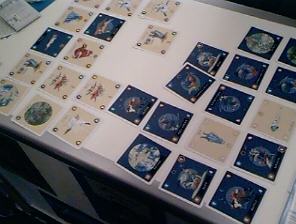 As for the graphical design, the other cardgame Ana contre Corax looked as promising as the first one did. However, I think that the rules in Ana contre Corax are better and provide for a much more interesting game. The background story is that the girl Ana and the raven Corax each have stolen the Talisman of the other. Thus, in a manner somewhere similar to Stratego but will all cards revealed, both players put up their protagonists with their friends against the other side to gain back their Talisman. Each character in this game has certain attributes, allowing him to run or fly for a certain number of movements and giving him different attributes in battle. Battle ensues when two characters meet, but players also have the possibility to join in with more characters in order to strengthen their side. A further quite nice turn is the fact that the characters have different magical attributes. When two characters of one side unite, then a special table for magic can be consulted to find out which kind of magic these two characters can conjure together. 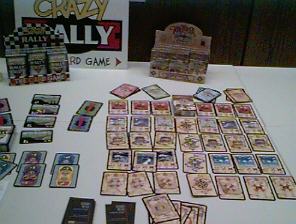 Just a few booths further another small cardgame publisher also was presenting their two new games. RED OMEGA STUDIO from Italy had come to Essen for the first time, and - funny enough considering the reviews above - they also had brought a pirate cardgame with them called Tortuga. In this game there is a fixed setup of the layout, with each player possessing a fleet of three pirate ships which he positions at his side of the playing area. To start the game, each player now will receive a set of hand-cards, and placing one card per turn the players now may add one of these cards to either their own or the opponents side of the playing area. Basically, there are five different types of cards which a player may have at his hand: He may have Ships, Treasures, Weather-Conditions and Strategy cards, and furthermore there are also some event cards (which may be used once the playing area has been filled up with cards). Below each of the 3 Pirate ships of each player now a combination of all four different kinds of cards need to be placed. A Ship to find a victim for the pirate, a Treasure to determine the victim's worth, Weather conditions to see whether the victim can spot the attacker, and a Strategy for the Pirate to decide which way he wants to attack the victim. Naturally, a player will try to assign a ship with weak defences and a valuable load to his pirate ships, but he will be faced with the problem that the opposing player also may place cards on his own side of the gameboard. Thus, even the most clever plan can be thwarted if the opposing player decides to play an unexpected card, and this in turn may destroy most of a player's careful plan. However, once all pirate ships haven been assigned the required 4 cards, some changes may still be done though the use of event cards which usually allow the exchange of two certain kinds of cards. Playing two rounds, the player who has succeeded to capture the most valueable Treasure will have won the game. Tortuga actually is a rather well playing two-player cardgame which causes much discussion and interaction between the players during play. It may have some unexpected twists, but making clever use of a player's hand of cards is essential for winning the game. The other game presented by RED OMEGA is Crazy Rally, a game which design somewhat reminds me of the old Arcade-game classic Pit Stop. In this game the players will send their cars on a race over a total of 14 road cards, and the player who has done the race at the highest speed will have won the game. At the beginning, each player will get to outfit his car with a few extras concerning its Handling, Restrictions and Maximum Speed, and after this is done a total of 14 track cards will be mixed up to generate the track for the road. Quite surprisingly, the track then is not spread out in front of the players, but instead the players together will go through the stack of road cards and they will - just as real Formula One Pilots - be required to remember the characteristics of the track. Then the race goes of, and using acceleration and braking cards the players now will drive over the track card by card. Once all players simultaneously have played either a braking or acceleration card, the track card for the current piece of road will be turned over and the players will compare their speed to the Safety Limit of that track card. If their speed is higher that the maximum speed of that piece of track, their car will get damaged, whereas they can go save if their speed is below the maximum. A car which gets too much damage during the race will crash and loose, whereas a car which goes too slow will have no chance at winning the race. Thus, a good memory is essential in this game to find a good combination between speed and safety. I liked the game a lot due to this rather ingenious playing mechanism, and once again it came to me as a pity that such a cute little game remains hidden for most of the public in one of the "back-corners" of the convention. The problem for new publishers always is that they will be given a booth which is a bit away from the main ways for the public, and thus such games get less attendance then they would deserve. However, talking to Mrs. Chies from RED OMEGA, she assured me that they did have a very good convention, both personally and economically, and that they certainly want to make the trip to Essen again next year. 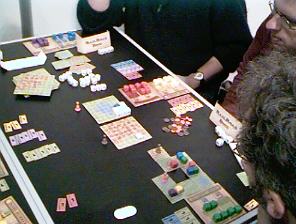 With these reports from smaller publishers my reports slowly draw to an end, but I have saved one more of the convention highlights right until the end. My final report will be on another small-publisher's game called Railroad Dice by Jens Kappe. The author actually has decided against releasing this game through a major company, which was due to the fact that he wanted to keep as many of his original rules of the game as possible and not to be subjected to the budget-planning of a major publisher. In this game, the players are trying to build railways and to set up train stations. The unique factor of the game is that all pieces of rails are made up by dice, and the players have to roll these dice during their turns in order to see what kinds of rails (turns or straights) they might be able to lay during their turn. The tracks a player has rolled are placed onto the current section of the gameboard, continuing the track which so far existed. In order to score points in the game, the players need to have as many train stations as possible on adjacent sections of the gameboard. However, a player may not simply put a station down whenever he desires to do so. Instead, he has to look for the special conditions of the Railroad company which he represents. So, while one company might be allowed to place stations on grassland, an other company might only be allowed to place their stations in mountains or next to a lake. Thus, a player has to use his track-dice in order to build the track to a place where he might be able to place a station. When the track leaves the current section of the gameboard, a smaller "map" which represents exactly the finished section of the gameboard will be added to an "overview map". All stations from the finished board are placed on this "overview map" in order to keep track where the different players had their stations. Next, a player may decide on which section of the gameboard he wants to continue the track, allowing the player to chose freely from all sections of the gameboard which were not used yet. As said, the player with most adjacent stations will win the game, but the full depth of the rules can only be hinted at within this review. There are several additional rules like random dice results or the trading of shares of the railroad companies which also carry influence on the outcome of the game, but the bare sketch of the rules which I have given above should be sufficient to give you some insight into this game. What I especially like about "Railroad Dice" is that it offers some unique rules which I have not seen in any game so far. The building of the tracks is an interesting and entertaining process, and having talked to the author a bit more I found out that he was quite surprised to find that the game was received well by big audience. Even some publishers were approaching the author, and thus it might happen that one day in the not all too far future we might see this game being published under the label of a well-known publisher. Well, and here we stand, with the gates of the SPIEL 03 slowly closing for this year. It's always sad when these days of bliss and gaming joy are over, but there always was and will be another convention next year! Kulkmann's Convention Hit"Finstere Flure" by Friedemann Friese  Actually I came to Essen without having heard anything about this game, so when Greg and Mik took me along to the booth on the first day of the convention I was rather curious to see what would expect me there. After playing the game the first time, I certainly got fascinated by its easy rules and the great fun it makes to play - especially if played with 5 or 6 players. The game is really entertaining, and because of this high Fun ratting and also the great graphical design I couldn't refuse this fine gaming gem my special convention award. What remains for me to say now is that I thank all of you who have left their comments in my guestbook. I appreciate all the remarks you have made, and I would love to hear any final comments you wish to make via email (kulkmann@aol.com). The Alhambra-Prize draw is still open and the winners will be published here on monday. Perhaps some final word needs to be said concerning wishes of games which I should review: I have tried my best to give you a broad choice of games in my reports, but due to the size of the convention I could not get around to fulfil all of your wishes. I hope that everybody did find something interesting in my reports, and I would like to welcome all of you back here at the G@mebox for the next SPIEL. See all of you next year! All the best ! Frank Schulte-Kulkmann "live" from Essen - turning off and getting some sleep... PRIZE DRAW !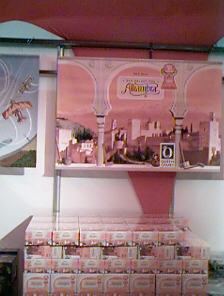 And what would my reports be without the anual prize draw? I already had a short chat with the owner of QUEEN GAMES, and as a special prized this year he sponsored two signed copies the QUEEN GAMES' Game of the Year: Alhambra And what do you have to do in order to win a game? That's easy enough: just leave an entry in my Essen 03 Guestbook ! And the Winners are...Humphrey ClerxandBenjamin (unknown surname)Thanks to all of you for participating and for leaving feedback! Seeing that so many people were watching and enjoying my reports was great! Queen Games
If you want to have a peek at my coverage of previous conventions, follow these links:
Opening timesFrom thursday to saturday the convention is opened from 10 AM until 7 PM, on sunday from 10 AM to 6 PM. Travelling to the Messe EssenIf you arrive at Düsseldorf International Airport, it takes about 20 minutes to get to the Messe Essen by Cab. If you hire a car at Düsseldorf Airport, you go onto Autobahn A44 (blue signs), and at the next motorway crossing you go over to A52, direction Essen. Take Exit "Essen Rüttenscheid". You can also go by train to Essen Central Station. If arriving there, go to the basement and take the Subway U11 directly to the Messe Essen. If you want to arrange lodging at Essen, you best contact the Essen-tourism-center by phone 0049/(0)201/19433 or 0049/(0)201/88720-46 or -48. Perhaps they know where some Hotel-rooms are left... |
|
| |

Looking for the new games? Visit Funagain Games! |
|
|
| |
|
Kulkmann@aol.com
Copyright © 2003 Frank Schulte-Kulkmann, Trier, Germany | |